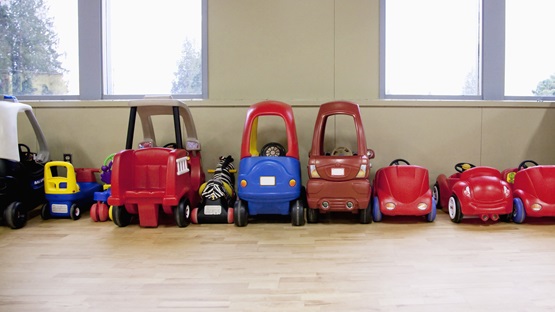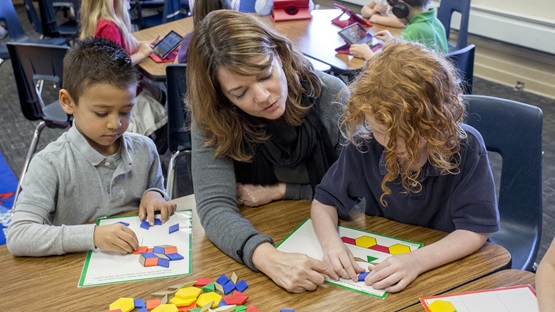During the COVID-19 pandemic, child care providers are subject to new safety guidelines that can significantly affect their revenues and costs. For example, following guidance from the Centers for Disease Control (CDC) and their own respective health departments, most states now limit group sizes at child care operations to 10. Group in this context refers to the children in a particular class or age grouping plus the adults assigned to work with them. In the analysis that follows, I use data from the Provider Cost of Quality Calculator (PCQC) to examine the impact that this limit on group size can have on child care providers in Minnesota. The findings suggest that child care centers face a substantial reduction in revenue as a result of the 10-person group limit: a hypothetical classroom of toddlers could lose about $2,600 in net income1 per month and a preschool classroom about $4,800 per month. The findings also suggest that the 10-person group limit can have an impact on home-based family child care providers if they typically serve more than nine children.
This analysis does not include several COVID-19-specific factors that increase costs for child care providers, such as sanitization-related costs and sick leave, nor does it account for reduced demand caused by the pandemic.2 Instead, I isolate the effect of a 10-person group limit on the business model for Minnesota child care centers and family child care providers.
Impacts on child care centers
Group sizes, costs, and revenues
Licensed child care centers must operate within an overall capacity limit and also limit child group sizes by the age of children. In Minnesota, group limits are eight, 14, 20, and 30 children for infants, toddlers, preschoolers, and school-age children, respectively. Meanwhile, maximum child-to-adult ratios are four, seven, 10, and 15, respectively.
Under a 10-person limit, group sizes are reduced to no more than nine children to one adult (see Table 1). In practice, this means:
- An infant classroom that is at full capacity would not need to change its makeup; that is, it could keep eight infants and two adults.
- A toddler classroom that is at full capacity would have to change from one lead teacher, one assistant, and 14 toddlers to one lead teacher and seven toddlers. Per classroom, the center would lose seven toddlers and one assistant.
- While the child-to-staff ratio for preschool children would remain the same, each classroom would serve less than half the number of children. The center would lose 11 preschoolers and one assistant per classroom.
- A school-age classroom that serves 30 children would decrease to nine children. Per classroom, the center would lose 21 school-age children and one assistant.3
| Classroom type | Ratios and group sizes from Minnesota licensing regulations | Ratios and group sizes to meet 10-person limit |
|---|---|---|
| Child-staff ratios (children per adult) | ||
| Infant | 4 | 4 |
| Toddler | 7 | 7 |
| Preschool | 10 | 9 |
| School-age | 15 | 9 |
| Maximum group size (children) | ||
| Infant | 8 | 8 |
| Toddler | 14 | 8* |
| Preschool | 20 | 9 |
| School-age | 30 | 9 |
The PCQC provides state-level estimates of personnel and non-personnel costs for child care centers and home-based family child care providers. Table 2 draws on those estimates to show expenses and revenue for a hypothetical Minnesota child care center licensed for 104 children that has two infant classrooms, two toddler classrooms, and three preschool classrooms, and that receives median center tuition rates for infants, toddlers, and preschoolers in Minnesota. (This case doesn’t include a school-age classroom, which is discussed separately below.) During normal operations, the center is assumed to have a 15 percent reduction in revenue from full-licensed-capacity due to unpaid tuition or inefficiency in filling open slots.4
In this example, the number of children served decreases from a baseline capacity of 104 children down to 57 children due to the 10-person group limit. Fixed non-personnel costs across classrooms remain the same from the baseline capacity to the 10-person group limit capacity, although per-child non-personnel costs decrease by the number of children no longer served. Teaching-personnel costs also decrease with fewer children, in this example by five teaching assistants. The number of lead teachers on staff remains the same, since the number of classrooms remains the same.
With a prolonged reduction in the number of children attending the center, administration staff would likely decrease. In this case, administration includes a director, instruction or development coordinator, and an administrative assistant. With enrollment decreasing by half, the instruction or development coordinator and administrative assistant positions are reduced to part-time, cutting costs by $48,280.
| Baseline (pre-COVID-19) | With 10-person group limit in place | ||||
|---|---|---|---|---|---|
| Number | Total | Number | Total | ||
| Non-personnel costs | |||||
| Per-child non-personnel costsa | $1,880 | 104 | $195,520 | 57 | $107,160 |
| Per-classroom costsb | $30,400 | 7 | $212,800 | 7 | $212,800 |
| Per-staff (teachers, assistants) costsc | $250 | 14 | $3,500 | 9 | $2,250 |
| Per-site costsd | $8,000 | 1 | $8,000 | 1 | $8,000 |
| Total | – | – | $419,820 | – | $330,210 |
| Personnel costs | |||||
| Director | $58,740 | 1 | $58,740 | 1 | $58,740 |
| Instruction or development coordinator | $58,740 | 1 | $58,740 | 0.5 | $29,370 |
| Administrative assistant | $37,820 | 1 | $37,820 | 0.5 | $18,910 |
| Teachers | $37,500 | 7 | $262,500 | 7 | $262,500 |
| Teacher assistants | $25,820 | 7 | $180,740 | 2 | $51,640 |
| Total | – | – | $598,540 | – | $421,160 |
| Mandatory benefitse | – | 11% | $65,839 | 11% | $46,328 |
| Total | – | – | $664,379 | – | $467,488 |
| Total expenses | – | – | $1,084,199 | – | $797,698 |
| Total potential revenue | – | – | $1,355,794 | – | $765,425 |
| Less slot turnover inefficiency, bad debt | – | 15% | $1,152,425 | 15% | $650,611 |
| Net income | – | – | $68,225 | – | -$147,086 |
| Baseline | With 10-person group limit in place | |
|---|---|---|
| Net income % of revenue | 6% | -23% |
| Total | |
|---|---|
| Decrease in revenue | $501,814 |
| Decrease in expenses | $286,502 |
| Total annual decrease in net income | $215,312 |
| Decrease in net income per month | $17,943 |
| Decrease in net income per month per childf | $315 |
From baseline to the 10-person limit, annual revenue decreases by $501,814 and expenses decrease by $286,502. The difference between the decrease in revenues and the decrease in expenses (decrease in net income) is $215,312 annually, $17,943 per month, or $315 per month per child.5
Some centers may have a shared space for family activities or large-motor-skill movement that could be repurposed as a classroom. During the pandemic, CDC guidelines recommend not holding group events and instead keeping children contained within their own classrooms, which could free up a shared space such as a family activity room or gym. In this hypothetical center, a shared space repurposed to a preschool classroom could mitigate the decrease in net income by $34,541, to $180,771 annually, which is $15,064 per month or $228 per month per child. Note that these figures don’t account for potential expenses necessary to make the room compliant with licensing regulations.
A center may also provide care for school-age children. This can be an important source of income, particularly given the large group size allowed and the high ratios of children to staff. Since centers often use space for school-age care for other purposes and care is provided part-time for much of the year, it’s more challenging to create a standard hypothetical example of a school-age classroom than it is for classrooms of younger children. With that said, a school-age classroom that serves 30 children will lose revenue from 21 children under the 10-person group limit. Given that school-age care prices, amount of care, and number of staff members required are lower for school-age children than for younger children, the financial impact of the 10-person group limit for a classroom of 30 school-age children is somewhat similar to that for a preschool classroom.
Analysis of a hypothetical child care center that is twice as large suggests that unless larger centers operate with a different relative decrease in administration costs than smaller centers, there isn’t much difference in the impact of a 10-person group limit between large and small centers.
Financial impacts by classroom
Child care is a business model with thin profit margins and little room for providers or families to pay extra to achieve health, safety, or child development goals. In this hypothetical case, the child care center makes pre-COVID-19 net income of only 6 percent of revenue. However, the value of this example isn’t in assessing profitability accurately, but in identifying how revenue and costs change from pre- and post-COVID-19 group size limits. In the hypothetical case, annual revenue decreases by about $180,000–$215,000 (about $15,000–$18,000 per month) more than costs decrease.
Group limits have substantially different impacts on the profitability of providing care for toddlers and preschoolers. Using figures from the hypothetical case, each toddler classroom is associated with a reduction of about $2,600 in net income per month and each preschool classroom is associated with a reduction in net income of about $4,800 per month (see Table 3). As mentioned above, the financial impact on a school-age classroom serving 30 children has more variability. The data in this example suggest the impact is about the same as on a preschool classroom.
| Baseline (pre-COVID- 19) | With 10-person group limit in place | |||
|---|---|---|---|---|
| Number of children | 14 | 20 | 7 | 9 |
| Type of classroom | Toddler | Preschool | Toddler | Preschool |
| Per-child non-personnel costs | $26,320 | $37,600 | $13,160 | $16,920 |
| Per-classroom costs | $30,400 | $30,400 | $30,400 | $30,400 |
| Staff costs | $63,320 | $63,320 | $37,500 | $37,500 |
| Mandatory benefits | $6,965 | $6,965 | $4,125 | $4,125 |
| Total | $127,005 | $138,285 | $85,185 | $88,945 |
| Administration | $23,000 | $23,000 | $16,000 | $16,000 |
| Total expenses | $150,005 | $161,285 | $101,185 | $104,945 |
| Revenue | $159,582 | $207,413 | $79,791 | $93,336 |
| Net income | $9,577 | $46,128 | -$21,394 | -$11,609 |
| Annual financial loss | – | – | -$30,971 | -$57,737 |
| Monthly financial loss | – | – | -$2,581 | -$4,811 |
Financial impacts on family child care and group family child care
In Minnesota, family child care and class-C1-licensed group family child care are both limited to 10 children total. Family child care is limited to six children younger than school-age and class C1 group family child care is limited to eight children younger than school-age. This suggests that these providers already operate with fewer than nine infants, toddlers, and preschoolers. However, programs operating at full capacity of 10 children before COVID-19 would need to reduce enrollment by one child under the 10-person group limit, likely a school-age child.
Providers with a group family child care class C2 or class C3 license are able to operate with up to 12 children6 and 14 children (with two adults),7 respectively. Under a 10-person group limit, a provider holding a class C2 license operating at maximum capacity would be limited to nine children below school age and would thus lose one preschool-age child and two school-age children. Over a year, such a provider would lose about 15 percent of revenue.8
In the case of a class C3 license, a provider operating at maximum capacity would be limited to nine children below school age.9 To adjust to the 10-person limit, a class C3 provider would likely operate like a class C2 provider, with one staff person providing care for nine children.
Family child care and most group family child care providers don’t have to change their business models as dramatically in response to group limits as do child care centers. In the case of class C2 and class C3 license holders that operate at maximum capacity, the 10-person group limit can reduce net revenue by about $1,200 per month, depending on the number of school-age children enrolled. Like many child care centers, family child care providers typically operate with thin margins. A family child care provider that loses even one or two school-age children could see a significant reduction in effective hourly wage.
Other considerations for this analysis:
- Child care provider costs and revenue are different in urban and rural areas. The examples in this analysis use state-level costs and median prices, which are smaller than those in the Minneapolis-St. Paul metro area and larger than in many rural areas.
- This analysis was reviewed by staff at First Children’s Finance and WomenVenture; both use more sophisticated child care models with localized information for regions in Minnesota. The results in this analysis are consistent with their models, but there is room to refine results for specific geographic areas.
Author’s note: I am grateful for comments on initial drafts from Aaron Sojourner and Elizabeth Davis, University of Minnesota; Heidi Hagel-Braid, First Children’s Finance; Jeff Andrews and Kaltrina Rezniqi, WomenVenture; Ann McCully, Child Care Aware of Minnesota; Jonathan May, Think Small; and Clare Sanford, New Horizon Academy.
Endnotes
1 In this example, net income refers to revenue minus expenses.
2 Rebecca Ullrich and Aaron Sojourner discuss these and other expenses child care providers face during COVID-19 in Child Care is Key to Our Economic Recovery (brief and technical appendix), published by CLASP (Center for Law and Social Policy) and the National Women’s Law Center.
3 Teachers and assistants in school-age classrooms work part-time much of the year and full-time during the summer.
4 The PCQC notes that child care providers are encouraged to keep enrollment at or above 85 percent of capacity and bad debt to less than 3 percent of revenue. In this example, the center has a combined enrollment inefficiency and bad debt of 15 percent—e.g., operating at 88 percent of capacity with bad debt of 3 percent of revenue. I assume the same 15 percent revenue reduction from maximum capacity both before and after the onset of COVID-19.
5 Another way to describe the impact of the 10-person group limit is to consider how per-child costs change from baseline to the 10-person limit. The annual cost per child in the baseline scenario is $10,425 (with 104 children). After implementing a 10-person group limit, the annual cost per child increases to $13,995 (with 57 children), or on a monthly basis, an increase of $297 per child.
6 Of the under-school-age children, two may be infants and toddlers with a maximum of one infant.
7 Of the under-school-age children, four may be infants and toddlers with a maximum of three infants.
8 This assumes the provider receives the Minnesota median family child care prices and maximizes the number of allowed infants and toddlers.
9 Ibid.





